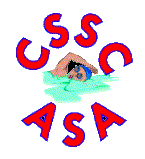|
| CSSC ASA |
 |
A
Potted History of the Civil Service Amateur
Swimming Association
1.
After the end of World War II Civil Service Swimming was in the very
capable hands of H G "Spud" Jones and L T "Laurie" London - the Hon General Secretary
and the Assistant Secretary respectively.
Both were members of H M Customs & Excise.
The Hon Treasurer at that
time was J T Stone of the Home Office.
2.
During this period swimming thrived in the Service,
particularly in the London Area where most Departments had their
Headquarters. As a consequence enthusiastic and sometimes quite large
swimming clubs were to be found. Notably
Customs & Excise, Savings Bank and the Board of Trade.
3.
Annual Galas were the norm during this period and were frequently well
attended by colleagues, family and friends.
Ironmonger Row Baths, off Old Street in the City, were often used as the
venue for many of these. The
Championships were not yet held centrally and the various open championships
were swum individually at these galas. Clubs
would tender for whichever event they thought they could afford and which would
enhance their own swimmers performances in their galas.
Typically £5 for the Men's 100 yds Freestyle
- the Blue Riband event
- would be offered and
usually accepted. Along with club,
and some individual, subscriptions this was the only source of income for the
Association. In those days the
costs of running the Association were fairly modest.
The Sports Council did not support
Civil Service swimming in the way it does today.
This only began after the Centralised Championships were introduced in
1965 at Derby Baths, Blackpool.
4.
The London Team Swimming League was especially strong at this time and
comprised up to 5 Divisions of varying sizes.
Teams of four swimmers met at lunch times, generally in public pools, and
swam against each other on a home and away basis.
Teams were promoted and relegated and there were medals for winners and
runners up as well as the Ellison MacCartney Trophy for the team who won the
Division 1.
5.
There was also a London Water Polo League which competed for the solid
silver F W Thompson Bowl (now renamed the ............................and given to the
winners of the ...............)
6.
Sadly both these competitions have gone.
Changes in the make up of the Civil Service meant that the old patterns
of work could not survive. Computerisation
and other forms of technology were
introduced and the process of decentralisation began.
The Savings Bank was the first Department to encounter this.
7.
Centralised Championships started
in 1965 in the Derby Baths at Blackpool. For
many years they were held there but gradually other venues began to be selected
to offer greater opportunities for provincial swimmers.
Coventry was one of the first followed by Felling in Co Durham.
There were others in later years such as Fleetwood, Norwich, King's Lynn,
Weston Super Mare, Plymouth, Margate and Leicester.
8.
These were generally well supported
and so Civil Service swimming survived in this form whilst many clubs
went into decline departmentally and numerically.
Many swimmers were given financial support to attend the championships by
their Departmental Sports Association but other smaller Departments did not.
9.
However, with the
introduction of Masters Competition swimming in 198...a resurgence of interest
appeared which has now resulted in the almost unmanageable numbers of entries
that we see today. It is doubtful
whether any other 'civil service sport' has achieved this much.
Such
numbers mean that we are now limited in our choice of venues -
8 lanes is the minimum whilst 10 lanes is the preferred and ideal
position.
10.
Over the years the standard of swimming against the three armed services
has improved. Particularly following the cessation of national
service. The Sports Council has
generously increased its financial support for the annual increase in the
Association's activities. Something
we must all be grateful for since without it national Civil Service swimming
would have foundered years ago.
11.
For the future we can look forward to greater achievements in both
swimming and diving. The latter appears to be making a comeback after many years
in the doldrums.
